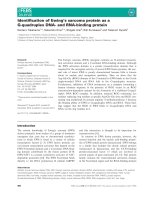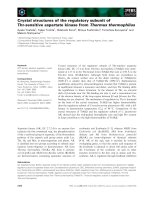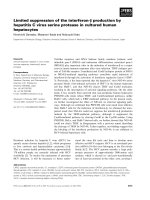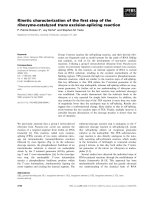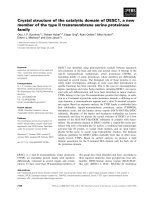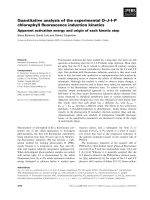Báo cáo khoa học: "Isolated recurrence of distal adenocarcinoma of the extrahepatic bile duct on a draining sinus scar after curative resection: Case Report and review of the literature" pptx
Bạn đang xem bản rút gọn của tài liệu. Xem và tải ngay bản đầy đủ của tài liệu tại đây (454.57 KB, 4 trang )
BioMed Central
Page 1 of 4
(page number not for citation purposes)
World Journal of Surgical Oncology
Open Access
Case report
Isolated recurrence of distal adenocarcinoma of the extrahepatic
bile duct on a draining sinus scar after curative resection: Case
Report and review of the literature
Jesús Rodríguez-Pascual
1
, Emilio De Vicente
2
, Yolanda Quijano
2
,
Francisco Pérez-Rodríguez
3
, Fernando Bergaz
4
, Manuel Hidalgo
1
and
Ignacio Duran*
1
Address:
1
Centro Integral Oncológico Clara Campal (CIOCC), Madrid, Spain,
2
Surgery Department, Hospital Madrid-Norte Sanchinarro, Madrid,
Spain,
3
Pathology Department, Hospital Monteprincipe, Boadilla del Monte, Madrid, Spain and
4
Radiology Department, Hospital Monteprincipe,
Boadilla del Monte, Madrid, Spain
Email: Jesús Rodríguez-Pascual - ; Emilio De Vicente - ;
Yolanda Quijano - ; Francisco Pérez-Rodríguez - ;
Fernando Bergaz - ; Manuel Hidalgo - ; Ignacio Duran* -
* Corresponding author
Abstract
Background: Surgical resection remains the gold standard for the treatment of localized
adenocarcinoma of the extrahepatic bile ducts. Yet, treatment of loco-regional recurrences is not
well defined.
Case Presentation: We present an unusual case of distal adenocarcinoma of the extrahepatic
bile ducts that was treated with surgery and relapsed two years later with a solitary recurrence on
the tract of a previous Redon drain. In addition, a review of the literature on management of loco
regional relapses is presented.
Conclusions: The ideal management of these patients still remains undefined. Decisions are made
based on clinical parameters from retrospective series, such as tumor grade, surgical margins or
lymph node involvement. Prospective studies, that include molecular and genetic markers, are
needed to improve patient selection and outcomes on this population.
Background
Biliary tract neoplasms are relatively infrequent malignan-
cies. Adenocarcinoma of the extrahepatic bile duct com-
prises around half of all bile duct neoplasms. Surgical
resection remains the gold standard for this disease
although adjuvant chemotherapy or radiation should be
considered in selected cases. Treatment protocols for loco-
regional recurrences are not well defined and include sur-
gery, chemotherapy, radiation, or best supportive care. We
present an unusual case of adenocarcinoma of the extra-
hepatic bile duct treated with surgery that relapsed two
years later with a solitary recurrence on the tract of previ-
ous Redon drain.
Case presentation
A 62 year-old Caucasian male presented with a seven-day
history of painless jaundice with no other accompanying
symptoms. His past medical history was remarkable for
Published: 14 December 2009
World Journal of Surgical Oncology 2009, 7:96 doi:10.1186/1477-7819-7-96
Received: 16 May 2009
Accepted: 14 December 2009
This article is available from: />© 2009 Rodríguez-Pascual et al; licensee BioMed Central Ltd.
This is an Open Access article distributed under the terms of the Creative Commons Attribution License ( />),
which permits unrestricted use, distribution, and reproduction in any medium, provided the original work is properly cited.
World Journal of Surgical Oncology 2009, 7:96 />Page 2 of 4
(page number not for citation purposes)
high blood pressure, hypercholesterolemia, coronary
artery disease, tuberculosis, abdominal aortic aneurysm
and benign essential tremor. At admission, physical exam-
ination revealed unremarkable findings aside from jaun-
dice. Imaging tests showed a hilar-hepatobilliary mass
consistent with the diagnosis of adenocarcinoma of the
extrahepatic bile ducts (extrahepatic cholangiocarci-
noma). On February 2003, the patient underwent a percu-
taneous biliary internal decompression followed by a
laparotomy and curative resection of the tumour by
cephalic duodenopancreatectomy. The resection was per-
formed successfully and histological examination
revealed an adenocarcinoma of the extrahepatic bile duct
with no lymph node involvement and clear microscopic
margins (pT2 pN0 as per AJCC classification)[1]. The
patient did not receive any adjuvant therapy and his fol-
low up consisted on CT scans, blood work, and physical
exams every six months. Two years after the initial surgery,
the patient complained of a four-month insidious and
progressive abdominal pain localized in the right upper
abdominal area along with a weight loss of around eight
kilograms. Physical exam was unremarkable and abdom-
inal imaging studies (including ultrasound and CT scan)
reported only post-surgical changes with no evidence of
recurrence. Blood work was notable for an elevated CA
19-9 at 880 Ku/L (normal range 0-39) with no other
abnormalities. A liver MRI and PET-CT revealed a long
string through the diaphragm, chest, and abdominal wall
that extended from the surgical bed, with an intense glu-
cose uptake at a standard uptake value of 7 (Figs 1 and 2).
With the diagnosis of isolated recurrence in the chest wall
of a previously resected cholangiocarcinoma, the patient
underwent a new surgical intervention consisting of an
en-bloc resection of segment VII of the liver, part of the
diaphragm and the whole 11
th
right rib.
Pathology analysis revealed a tumour implant through
the drainage course where the Redon tube was placed in
the first liver procedure (Fig 3). No tumour was observed
in the liver parenchyma and surgical margins were free of
malignant cells.
After the successful resection of this unusual recurrence,
the patient received six courses of adjuvant chemotherapy
(gemcitabine and oxaliplatin) with good tolerance[2]. On
Abdominal MRiFigure 1
Abdominal MRi. Isolated recurrence in chest wall of a pre-
viously resected cholangiocarcinoma: long string through the
diaphragm, chest, and abdominal wall that extended from the
surgical bed.
PET-CTFigure 2
PET-CT. Isolated recurrence in chest wall of a previously
resected cholangiocarcinoma: intense glucose uptake.
Surgical specimenFigure 3
Surgical specimen. Tumour implant through the drainage
course where the Redon tube was placed in the first liver
procedure.
World Journal of Surgical Oncology 2009, 7:96 />Page 3 of 4
(page number not for citation purposes)
December 2007, twelve months after finishing adjuvant
treatment, the patient presented again with abdominal
pain, fever, and hypotension. A mass in the right upper
quadrant was palpated on physical exam and imaging
studies revealed the presence of a 10 cm lesion involving
the chest wall, liver, and lung. Puncture of the mass con-
firmed the presence of adenocarcinoma as well as a puru-
lent collection complicating this lesion. In spite of multi-
antibiotic treatment and drainage of the collection, the
patient died on January 10
th
2008 due to refractory septic
shock.
Discussion
Management of resectable bile duct adenocarcinoma
Adenocarcinoma of the extrahepatic bile duct are rela-
tively infrequent malignancies representing less than 5%
of all solid tumors in adults and accounting for approxi-
mately 0.5% of all cancer deaths[3]. Adenocarcinomas of
the extrahepatic bile duct (previously referred as extrahe-
patic cholangiocarcinomas) are also distinguished as
proximal or distal, depending on their location along the
bile ducts.
Surgery provides the only possibility for cure in these neo-
plasms. Distal cholangiocarcinomas have the highest
resectability rates, while proximal tumors have the lowest
(particularly perihiliar neoplasms) [4-6]. In one large
series, the resectability rates for distal, intrahepatic and
perihiliar lesions were 91, 60 and 56 percent respec-
tively[7]. Even in patients who undergo potentially cura-
tive resection, tumor free margins can be obtained in only
20 to 40 percent of proximal and 50 percent of distal
tumors[8]. These numbers are even lower if a proximal
tumor free margin of at least 5 mm is considered to con-
stitute a curative procedure[9]. Thus, although surgical
resection remains the gold standard for this disease, long
term survival is rarely achieved because of frequent post-
operative recurrences [10,11].
The main clinical criteria for resectability are: absence of
retropancreatic and paraceliac nodal metastases, no dis-
tance liver metastases or disseminated disease, absence of
invasion of the portal vein or main hepatic artery
(although in many cancer centers, including our institu-
tion, en bloc resection with vascular reconstruction can be
considered), and absence of extrahepatic adjacent organ
invasion [12].
Patients with positive margins after resection or positive
regional lymph nodes should be considered for adjuvant
5FU-based chemotherapy as well as radiation. Yet, no ran-
domized trials have been conducted that support a stand-
ard regimen. Individuals with negative margins after
surgery and negative regional lymph node involvement
can either be observed or treated with adjuvant strategies
[13].
Follow-up after resection and diagnosis of loco-regional
relapse
No clear guidelines exist for follow-up after surgery in this
particular tumor type. Physical exam with routine labora-
tory tests every 3 to 4 months for the first 3 years post-sur-
gery and then at longer intervals of 6 months until year 5
seems a reasonable approach. The role of CA 19-9 level in
surveillance is not clear, but persistently rising levels often
precede radiological evidence of recurrence by a number
of months. Therefore this marker has been routinely
incorporated in follow-up schemas. Which imaging tests
to be performed is a topic that has not been specifically
addressed in prospective trials, although CT scans of the
abdomen every 6 months for 2 to 3 years after surgery is
probably the most common approach in routine practice.
However, as referred in the case presented, in several occa-
sions CT and abdominal ultrasound are not sufficient to
detect loco-regional relapses, which could be easily deter-
mined on MRI and PET.
While recurrence is mostly loco-regional in the majority
of proximal tumors, distal cholangiocarcinomas recur fre-
quently at distant sites including the liver, peritoneum,
and lung[14,15]. Like pancreatic, gallbladder and hepa-
tocelular cancers, adenocarcinomas of the bile duct have a
predisposition to seed an can recur in needle biopsy tracts,
abdominal wall incisions wounds and the peritoneal cav-
ity, and therefore it is recommended to be especially care-
ful in the physical exams in each follow-up visit.
Clinical management of loco-regional relapse
The case presented illustrates an example of an unusual
pattern of relapse for adenocarcinoma of the extrahepatic
bile duct on a draining sinus from a previous surgical pro-
cedure. Moreover it shows how the ideal management of
these patients still remains undefined. No prospective
data exist to set definitive recommendations about the
optimum treatment after a curative resection of adenocar-
cinoma of the extrahepatic bile ducts. Currently, decisions
are made based on different clinical parameters that have
been established as prognostic factors in retrospective
series, such as tumor grade, surgical margins, or lymph
node involvement.
Surgery is generally not indicated for recurrent bile duct
adenocarcinoma due largely to the location of recurrence,
technical difficulty, frequent distant metastases and
aggressiveness. However, in patients with prolonged
relapse-free interval and favorable location, should be an
option to consider.
More recently, several molecular markers have been
explored as possible determinants of invasiveness and
relapse. Expression of EGFR, HER2 and VEGF has been
correlated with disease recurrence and could be incorpo-
rated into the decision-making process of deciding adju-
Publish with BioMed Central and every
scientist can read your work free of charge
"BioMed Central will be the most significant development for
disseminating the results of biomedical research in our lifetime."
Sir Paul Nurse, Cancer Research UK
Your research papers will be:
available free of charge to the entire biomedical community
peer reviewed and published immediately upon acceptance
cited in PubMed and archived on PubMed Central
yours — you keep the copyright
Submit your manuscript here:
/>BioMedcentral
World Journal of Surgical Oncology 2009, 7:96 />Page 4 of 4
(page number not for citation purposes)
vant treatment in this patient population [16]. Another
retrospective analysis investigated the correlation of c-
met, cox2, and IL6 expression with invasiveness and
lymph node metastasis in a series of 114 patients [17].
Additionally, the importance of epigenetic alterations in
the process of cholangiocarcinogenesis has been high-
lighted recently with respect to their potential as diagnos-
tic and prognostic tools [18].
Conclusions
The current management of patients with relapsed adeno-
carcinoma of the extrahepatic bile duct after resection of
the primary tumor remains poorly defined and is based
only on small retrospective series. Further prospective
studies are required in order to design the most appropri-
ate treatment strategy on this population. In addition to
the clinical knowledge, it may be beneficial to incorporate
molecular and genetic markers into the treatment deci-
sion algorithm of this neoplasm.
Consent
Written informed consent was obtained from the patient
for publication of this case report and any accompanying
images. A copy of the written consent is available for
review by the Editor-in-Chief of this journal.
Competing interests
The authors declare that they have no competing interests.
Authors' contributions
JRP and ID conceived the idea for the manuscript, con-
ducted a literature search, and drafted the manuscript.
EDV and YQ performed surgery, obtained specimen
images and critically revised the manuscript. FPR pro-
vided and reviewed pathological images FB obtained radi-
ological images used in the manuscript. MH critically
revised the manuscript. All authors read and approved the
final manuscript.
References
1. Sobin LH, Wittekind C: TNM Classification of Malignant Tumours (UICC)
6th edition. New York: Wiley-Liss; 2002.
2. Eckel F, Schmid RM: Chemotherapy in advanced biliary tract
carcinoma: a pooled analysis of clinical trials. Br J Cancer 2007,
96:896-902.
3. Jemal A, Siegel R, Ward E, Hao Y, Xu J, Murray T, Thun MJ: Cancer
statistics, 2008. CA Cancer J Clin 2008, 58:71-96.
4. Nakeeb A, Lipsett PA, Lillemoe KD, Fox-Talbot MK, Coleman J, Cam-
eron JL, Pitt HA: Biliary carcinoembryonic antigen levels are a
marker for cholangiocarcinoma. Am J Surg 1996, 171:147-152.
discussion 152-143
5. Tompkins RK, Saunders K, Roslyn JJ, Longmire WP Jr: Changing
patterns in diagnosis and management of bile duct cancer.
Ann Surg 1990, 211:614-620. discussion 620-611
6. Schoenthaler R, Phillips TL, Castro J, Efird JT, Better A, Way LW:
Carcinoma of the extrahepatic bile ducts. The University of
California at San Francisco experience. Ann Surg 1994,
219:267-274.
7. Nakeeb A, Pitt HA, Sohn TA, Coleman J, Abrams RA, Piantadosi S,
Hruban RH, Lillemoe KD, Yeo CJ, Cameron JL: Cholangiocarci-
noma. A spectrum of intrahepatic, perihilar, and distal
tumors. Ann Surg 1996, 224:463-473. discussion 473-465
8. Burke EC, Jarnagin WR, Hochwald SN, Pisters PW, Fong Y, Blumgart
LH: Hilar Cholangiocarcinoma: patterns of spread, the
importance of hepatic resection for curative operation, and
a presurgical clinical staging system. Ann Surg 1998,
228:385-394.
9. Sakamoto E, Nimura Y, Hayakawa N, Kamiya J, Kondo S, Nagino M,
Kanai M, Miyachi M, Uesaka K: The pattern of infiltration at the
proximal border of hilar bile duct carcinoma: a histologic
analysis of 62 resected cases. Ann Surg 1998, 227:405-411.
10. Kurosaki I, Hatakeyama K, Tsukada K: Long-term survival of
patients with biliary tract cancers with lymph node involve-
ment. J Hepatobiliary Pancreat Surg 1999, 6:399-404.
11. Todoroki T, Kawamoto T, Koike N, Takahashi H, Yoshida S, Kashi-
wagi H, Takada Y, Otsuka M, Fukao K: Radical resection of hilar
bile duct carcinoma and predictors of survival.
Br J Surg 2000,
87:306-313.
12. Chamberlain RS, Blumgart LH: Hilar cholangiocarcinoma: a
review and commentary. Ann Surg Oncol 2000, 7:55-66.
13. McMasters KM, Tuttle TM, Leach SD, Rich T, Cleary KR, Evans DB,
Curley SA: Neoadjuvant chemoradiation for extrahepatic
cholangiocarcinoma. Am J Surg 1997, 174:605-608. discussion
608-609
14. Jarnagin WR, Ruo L, Little SA, Klimstra D, D'Angelica M, DeMatteo
RP, Wagman R, Blumgart LH, Fong Y: Patterns of initial disease
recurrence after resection of gallbladder carcinoma and
hilar cholangiocarcinoma: implications for adjuvant thera-
peutic strategies. Cancer 2003, 98:1689-1700.
15. Kitagawa Y, Nagino M, Kamiya J, Uesaka K, Sano T, Yamamoto H,
Hayakawa N, Nimura Y: Lymph node metastasis from hilar
cholangiocarcinoma: audit of 110 patients who underwent
regional and paraaortic node dissection. Ann Surg 2001,
233:385-392.
16. Yoshikawa D, Ojima H, Iwasaki M, Hiraoka N, Kosuge T, Kasai S,
Hirohashi S, Shibata T: Clinicopathological and prognostic sig-
nificance of EGFR, VEGF, and HER2 expression in cholangi-
ocarcinoma. Br J Cancer 2008, 98:418-425.
17. Joo HH, Song EY, Jin SH, Oh SH, Choi YK: [Expressions and clin-
ical significances of c-met, c-erbB-2, COX-2, and IL-6 in the
biliary tract cancers]. Korean J Gastroenterol 2007, 50:370-378.
18. Sandhu DS, Shire AM, Roberts LR: Epigenetic DNA hypermeth-
ylation in cholangiocarcinoma: potential roles in pathogene-
sis, diagnosis and identification of treatment targets. Liver Int
2008, 28:12-27.


